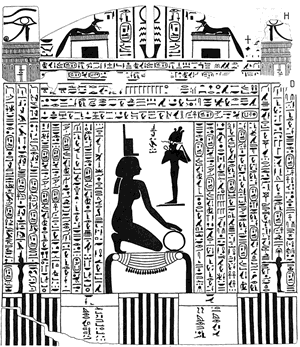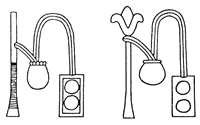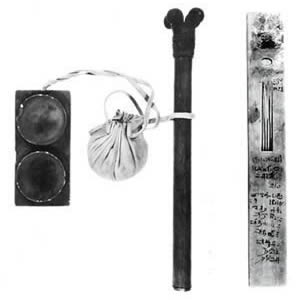The Art of Written Forms
The Development of Egyptian Writing
Egyptian Hieroglyphs (from the Greek for 'sacred carving' after the Egyptian for 'the god's words') are perhaps one of the best known of the many scripts in existence, created and used by a race of people with an
...extraordinary sense of design... sensitive to the remarkable decorative and textural qualities of their hieroglyphs.
(Meggs, 1992)
Never has a script been so widely used - furniture, clothing, utensils, buildings and jewellery, all baring hieroglyphic inscription for both decorative and inscriptional purposes. They were also very important to them in the afterlife with inscriptions on coffins, interiors and exteriors of tombs, funeral texts etc. Quite often colour was used, as well as raised and incised reliefs.
Yet we have no idea where Egyptian hieroglyphs came from - they do not seem to evolved over a period of centuries, but appeared almost suddenly, fully developed around 3100BC, just before the beginnings of dynastic Egypt. However, similar designs that resemble or closely match Egyptian hieroglyphs have been found from centuries before on pottery and weapons etc. These signs represented topographical and geographical features, concepts and tribes. Some think these may be the precursors to the hieroglyphic script, but most regard these as slowly evolved artistic repertoire, from which the first hieroglyphs were chosen.
The idea of writing may have come to the Egyptians from a nearby area, or they may have stumbled on it independently. The stimulus may have come from a system of writing that had started in Mesopotamia around 3300BC. There are certainly differences between Egyptian hieroglyphics and Sumerian Pictograms: in the shapes and signs, the fact that Egyptian hieroglyphics used a consonantal system (not marking vowels), but the basic idea of phonography is likely to have been borrowed from the Sumerians.
Hieroglyphic Fundamentals
The discovery of the 'Rosetta Stone' in Egypt in 1799 allowed the long mis-understood hieroglyphs to be read. The inscription on the stone was written in three different scripts: Egyptian hieroglyphs, Demotic (a cursive form of the hieroglyphic script), and Greek. From this the fundamentals of hieroglyphs were deduced by Jean-François Champollion (with help from earlier decipherment by Thomas Young) who announced it in 1823. He discovered that the writing system consisted semantic signs (symbols that stand for words and ideas), phonetic signs (representing one or more sounds), pictograms (recognisable pictures of objects, or used as phonograms depending on the context).
The hieroglyphic script utilised a basic set of 24 signs, somewhat like an alphabet except of course for the fact that this was uniconsonantal - containing no vowels. This begs the question: if the Egyptians had an alphabet, why the need for the many hundred of other signs, seeming to make things far more complicated. There are two arguments, both of which have evidence to support them. The first is that the Egyptian elite was deeply conservative and jealously reserved the knowledge of how to read and write hieroglyphs. The second is that, although it seems complicated to us, it would not have done to the ancient Egyptians, with a mixed system of phonograms and high proportion of logograms being more efficient.
Hieroglyphs can be classed into five following groups:
- Uniconsonantal - the 24 basic signs in the fore mentioned 'alphabet'
- Biconsonantal
- Triconsonantal
- Phonetic complements - the addition of a uniconsonantal sign (or signs) to a word so as to emphasise/confirm the pronunciation of a word
- Determinatives - logograms added to the end of phonograms to indicate a words meaning/discriminate were two meanings are possible

As for the direction of writing, this could be either from left to right, right to left, or even boustrophedon ('as the ox turns' i.e left to right, right to left, then back again left to right), using both horizontal and vertical formats. In many cases, in manuscripts and monuments alike, different directions could be seen to be in use at the same time (as seen above: a detail of the designs inscribed into a granite sarcophagus depicting Aspalta, King of Ethiopia, 593-568 BC). There was never any particular reason for the use of one direction over another other than for aesthetic appeal, symmetry or in showing respect for Gods, Kings etc. In order to know which direction a particular script has been written, you look for the direction in which the animals depicted, face.
Hieroglyphic Development
The hieroglyphic script was in no way static, or set in stone.
The iconic element of Egyptian hieroglyphs reflected important features of Egyptian life; individual signs sensitive to historical and/or conceptual changes.
(Gaur, 1997)
 The sign for the scribe is a perfect example (right), with earlier versions depicting a reed pen case and bag, whilst later versions show wooden pen cases and a water jar, mirroring changes in writing materials.
The sign for the scribe is a perfect example (right), with earlier versions depicting a reed pen case and bag, whilst later versions show wooden pen cases and a water jar, mirroring changes in writing materials.
Major steps forward in the development of the Egyptian hieroglyphic script came with the development of papyrus (from the Egyptian 'pa-en-per-aa': that which belonged to the king'). This writing surface came as a product of the Cyperus Papyrus plant that grew along the banks of the River Nile. It's flowers where used as garland at temples, the root used for fuel and utensils, and from the stem soils, mats, cloth, rope, sandals and of course papyrus.
In the Roman historian Pliny the Elder's 'Natural History', he describes how papyrus was made. The first stage in producing papyrus after peeling away the rind was to cut the inner pith of the stems into longitudinal strips and lay them side by side before a second layer of strips were laid on top of the first layer at a right-angle.
These two layers were then soaked in the River Nile before being pressed and hammered into a single sheet (the glutinous sap from the plant acting as a glue to bind the layers together) and then dried in the sun. The sheets were then taken to an ivory or stone polisher to be smoothed. If any flaws were found such as spots and stains or spongy areas appeared, the sheet was peeled apart and re-made. The sheets had two different surfaces - the upper surface which had the horizontal strips called the 'recto', and the bottom side of vertical strips - 'verso'. Eight different grades of papyrus were produced, for uses ranging from royal proclamations, to daily accounting.
With the increased and ease of use for such a writing material, it follows that a cursive form of the hieroglyphic script or 'book hand' came into existence with the carefully drawn symbols simplified a little into quickly drawn gestures. Around 1500BC a cursory 'hieratic' script (taken from the Greek for 'priestly') developed - a pen stroke simplification of the book hand and, as it name suggests, was used by priests for religious writings.
The earliest hieratic script differed from the hieroglyph only in that the use of the rush pen, instead of a pointed brush, produced more abstract characters with terse, angular quality.
(Meggs, 1992)
Later still, a furthermore abstract script evolved - 'demotic' (from the Greek word for 'popular') and came into everyday use for commercial and legal writings by about 400BC.
The evolution of the hieroglyphic script.

- hieroglyphic, c. 1500BC
- hieroglyphic, c. 500-100BC
- hieratic 'book hand', c. 1500BC
- hieratic, c. 1900BC
- hieratic, c. 1300BC
- hieroglyphic, c. 200BC
- demotic, 400-100BC
The population of ancient Egypt is relatively unknown, but it is estimated that it was somewhere close to 1 million at the time of the Old Kingdom, reaching 4.5 million by the Greco-Roman period. Of these perhaps only 1% were literate, and the majority of these being Greek later on. This meant in the Old Kingdom, perhaps only 10,000 people were actually able to read and write. It follows then that the profession of scribe was well-respected. In fact so respected that scribes were except from taxation!

A slate palette, a reed brush holder and drawstring sack for dried ink cakes. On it's right a scribes palette with hieratic script inscription
A trademark of the scribe was the wooden palette, with one end having two depressions, one to hold black and one to hold red ink and sometimes other ink 'cakes'. These ink cakes were made by using carbon for black, ground red ochre for red bound together with a gum solution and dried in the sun. These just required a wet brush to be rubbed over them to return the ink to a liquid state, similar to today's watercolour palettes. A slot in the middle of the palette held the scribes brushes. The brushes were made from rush stems, with the tips cut at an angle and chewed to separate the fibres into a brush.
Conclusion
Early classical scholars, thought that Egyptian hieroglyphics were able to be read much in the same way as both Latin and Greek, with Diodorus Siculus stating that egyptian hieroglyphs do not express the intended concept by means of syllables joined to one another, but by means of the significance of the objects which have been copied
, meaning for example a crocodile could signify anything evil, a hawk anything that happened swiftly. Others just considered them to be no more than magical symbols for sacred rites. However, this ancient and long extinct form of writing was far more complicated than that, yet at the same time very flexible also.
The Egyptians being a race of people that obviously enjoyed fine art and liked things to look good, had a script that they were able to use in a variety of ways for a variety of objects - truly anart of a written form. It is no surprise then, that it was the Egyptians that were the first to produce illustrated manuscripts in which both words and pictures combined to communicate information. It is also of no surprise that they allowed the script to evolve, in such a way that the later hieratic scripts are completely indistinguishable form their original hieroglyphic form.
Bibliography
- Meggs, P (1992) - A History of Graphic Design
- Van Nostrand Reinhold
- Gaur, A &; Saasson, R (1997) - Signs, Symbols and Icons
- Intellect
- Robinson, A (1997) - The Story of Writing.
- Thames & Hudson
The Art of Written Forms
Four resulting essays from my second year degree elective programme.
